Cuajo
This page is based on information from Crisanta Ruisz, kindly passed on to me by Angela Ruisz and Adam Courtney.
- Introduction
- Players and cards
- Objective
- Deal
- Secret
- Purro
- End of the game, scoring
- Remarks on etymology and relationships to other games
Introduction
Cuajo is a game of the rummy family played in the Philippines. Although the cards used are of Spanish design, the game shows signs of being of Asian origin - the likely relationship to Chinese cards and games is discussed below.
Players and cards
Cuajo is usually played by 4 players: the players sitting opposite each other are partners.
A special 112 card Spanish suited pack is used. The suits are cups, coins, swords and batons, and each suit contains seven different cards: ace, 3, 4, 5, jack, horse, king. There are four identical copies of each card, so 28 cards of each suit altogether.
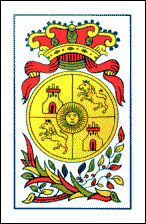
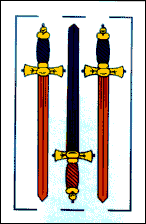
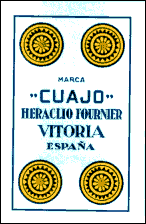
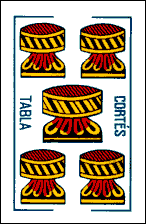
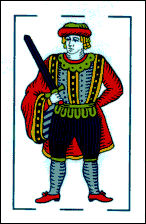
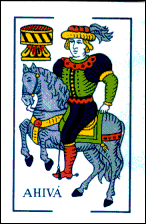

Packs of this type are made by the Spanish playing-card company Fournier and sold under the name "Cuajo Filipino".
Objective
The aim is to form all the cards in your hand into valid combinations. There are four types of combination that can be used:
- A set of three or four cards of the same rank in different suits.
- A sequence of 3 cards, consisting of either 3-4-5 or jack-horse-king in one suit. Note that these are the only possible types of sequence. Aces cannot be used in sequences.
- A set of four identical cards, known as a secret.
- A king by itself is a valid combination (though it can alternatively be used as part of a set, sequence or secret). This means that you can have any number of kings in any suits in your final hand.
Deal
Deal and play are anticlockwise. Any player can deal first; thereafter the winner of each hand deals the next. The dealer shuffles and the player to dealer's left cuts. The cards are dealt as follows: a batch of 5 cards to each of the other players and 6 cards to the dealer, followed by two more rounds of 5 cards to each player. So the dealer has 16 cards and the other three players have 15 cards each. The next card is placed face up on the table - it is called the sowee; it is not used in the play of the game but it has an effect on the scoring. The remaining undealt cards are placed face down on the table to form a stock; they are placed on top of the sowee but at right-angles to it, so that its value can be seen during the game.
Play
The dealer begins by discarding one unwanted card - not a king - face up beside the stock, so that the dealer then has 15 cards, like the other players. This is the start of the discard pile.
The turn to play passes to the right. At your turn you take either the top card of the face-down stock or the previous player's discard and add it to your hand. You then discard any card except a king from your hand face up on top of the discard pile.
Secret
If you manage to collect all four identical copies of one card in your hand, at your turn you can place them face down on the table in front of you before discarding. This set of four cards is known as a secret, because the other players do not know the identity of this card of which you have a monopoly. For putting down a secret, you are immediately paid 50 cents by each opponent (your partner neither pays nor receives anything). Cards forming a secret for which you have been paid cannot later be discarded or used as part of any other combination.
The three cards that are identical to the sowee can also form a secret: to claim payment you lay these three cards face down in front of you together with any fourth card from your hand. This fourth card will need to be incorporated into some valid combination if you are later to win the hand, but as part of your secret it cannot be discarded or looked at again until the end of the play. Since kings cannot be discarded in any case, a king is a good choice for the fourth card when you have a secret of the sowee.
Purro
The aim of the game is to have 16 cards formed into valid combinations - see objective. These combinations must be separate from each other - each card can only be used in one of the combinations in your final hand. Since your hand normally consists of only 15 cards, in order to complete it you need to acquire a sixteenth card, which would either be drawn from the stock or the top of the discard pile at the start of your turn, or taken from another player as described below.
When at the end of a turn you reach a position when you need only one card to complete your hand, you should say "purro" immediately after discarding. You also place a king from your hand face up on the table as a reminder that you need only one more card; if you have no king, you can place some other token in front of you, such as a coin.
From this point on, each of the other players, when drawing from the stock, must show the card they draw to all the other players. If it completes the hand of the player who said purro, then that player says "time", claims it and wins. After you have said "purro", it is also possible to win at your own turn by drawing the card you need from the stock or by taking the card discarded by the player to your left. The winning hand must be exposed for all players to see, to show that the win is valid.
Note that if a player other than the player immediately to your left discards the card you need to complete your hand, you are not allowed to take this card, since it is not your turn to play next. Even if the next player in turn picks up this discard, you are not allowed to take it, since you can only win when it is not your turn by taking a card that was drawn from the stock.
If two or more people have said purro, and a card is drawn that completes more than one hand, if the card completes the hand of the player who actually drew the it then that player wins; otherwise the winner is the next player in anticlockwise order around the table in the direction of play whose hand is completed - i.e. the player whose next turn would have come soonest.
It can happen that after you have said purro, on a later turn you draw a king which does not complete your hand. In that case you have to discard some other card, and if your hand can no longer be completed with one card you must announce that you are no longer purro and take back the king or token that you placed on the table. If no one else is purro, the other players no longer have to show the cards they draw until someone becomes purro once more. However, for the next two turns after you stopped being purro, you must show the card you draw to the other players, and on these two turns you are not allowed to announce purro again (or to win). At your third turn after your purro was destroyed, you revert to playing normally - you do not have to show the card you draw and you can announce purro again if you need only one card.
Given the large number of cards in the pack, it is very rare for the stock would run out before anyone has collected a winning hand, but if it happens, the hand is a draw and there are no payments (except for the payments that have already been made for any secrets that the players put down). The same player deals again in this case.
End of the game, scoring
In all cases, the winner (the player who has succeeded in collecting 16 cards in valid combinations) is paid by each opponent: the winner's partner neither pays nor receives anything.
The amount of the payment is partly based on the kings that the winner has. The value of the kings is:
- 50 cents for each king of coins;
- 20 cents for each other king.
The final card with which you win the hand is called the bounit. If you draw this winning card from the stock yourself, you are paid $1.10 plus the value of your kings by each opponent.
If you win by claiming your bounit from some other player as they draw it (as you are entitled to do if you are purro) or if you take your bounit from the discard pile, the previous player having discarded it, then in order to win the full $1.10 plus kings you have to satisfy two further conditions.
- You must have two cards that "go with" your bounit.
- You must have a card identical to the sowee plus two cards that "go with" it.
To "go with" an ace, you need two other aces of different suits (different from each other and from the first ace). To "go with" any other card you need the two cards of the same suit that would form a run with that card - for example you would need a horse and a king of cups to go with a jack of cups.
To satisfy these conditions, the cards that go with your bounit and sowee do not have to be used in the same combination with it. For example if your hand is:
- coins: 1 3 4 5 jack ;
cups: 1 3 4 jack ;
swords: 3 5 jack ;
batons: 1 4 5 king
and the sowee is the 4 of coins, then you have the 3 and 5 of coins to go with your sowee, even though in order to win with this hand the cards have to be arranged as a set of threes, a set of fours and a set of fives, not a run in coins.
If you cannot satisfy the conditions from your winning hand, you are allowed to draw up to 15 extra cards from the top of the stock, looking for the cards you need. These extra cards from the stock do not have to be incorporated in combinations - they are only used to help satisfy the two conditions, and if they do you are paid $1.10 plus the value of the kings in your hand (kings drawn from the stock among the extra 15 cards do not entitle you to any extra payment).
If, having drawn 15 cards from the stock, you still cannot meet both comnditions, your payment is reduced as follows:
- If you satisfy only condition 1 - i.e. you have the two cards to go with your bounit, but you are either missing either the sowee, or do not have two cards to go with the sowee, you are paid only 60 cents plus the value of your kings by each opponent.
- If you satisfy only condition 2 - i.e. you have the sowee and the two cards that go with it, but do not have two cards to go with your bounit, you are paid only 70 cents plus the value of your kings by each opponent.
- If you satisfy neither condition you are paid only 20 cents plus the value of your kings by each opponent.
A winning hand that contains no kings at all, or just one king used in a jack-horse-king run is known as "porbis". For winning with a porbis hand you are paid $3.00 by each opponent, irrespective of whether you draw the winning card or claim it from another player, and irrespective of the sowee, bounit and cards that go with them. Because it is illegal to discard kings, porbis hands are rather rare.
Remarks on etymology and relationships to other games
It was Anthony Smith who first observed, during some correspondence on the playing-cards mailing list, a possible connection with Chinese chess cards. C.T.Dobree, in his book Gambling Games of Malaya, listed Kua Oh as one of the games played with the 112-card four colour chess pack. Anthony Smith suggested that the name Cuajo might have been derived from this.
The rules of Cuajo given above provide support for this theory. Unfortunately, Dobree's book does not include rules for Kua Oh, but rules for a rummy game played with four colour chess cards can be found from a link on the Si Se Pai page of this web site. There is a strong family resemblance between Cuajo and Si Se Pai: the aces in Cuajo correspond to the pawns, the 3-4-5 are the field group horse-chariot-cannon, and the Cuajo picture cards are the command group elephant-advisor-general. The king corresponds to the general, and it is striking that both games allow this card to be melded by itself. The four suits in Cuajo correspond to the four colours of the chess cards.
So it seems quite likely that Cuajo is a direct adaptation of a game formerly played with chess cards - possibly Dobree's Kua Oh - in which the original Chinese cards have been replaced by appropriate cards from a quadrupled Spanish pack.
Anthony Smith also pointed out that the Chinese characters given by Dobree for Kua Oh are 看湖. In Mandarin this would be read as "kan hu", which is strongly reminiscent of Kanhoo, the name of a Chinese rummy game popularised in the West by W.H.Wilkinson in 1891. Kanhoo used money cards rather than chess cards, and the detailed rules are somewhat different. Possibly the name 看湖 has been used in China to refer to several different rummy games, just as the English word "rummy" can refer to a number of different but related games.
Thierry Depaulis writes:
"I came across two interesting references:
- Manuel, E. Arsenio. Chinese elements in the Tagalog language. Manila : Filipiniana Publications, 1948
- "Kuwaho. [khoàn (to see) - o (a particle expressing the end of a game), a Ch. game of cards for four players; FF. huaho, a game of cards.] A game of cards played by four persons only. Magkuwaho, to play the game; magpakuwaho, to hold the game under a management; magkukuwaho, a player." (p. 33) [FF. = Formosan Fukienese]
Yap, Gloria Chan. Hokkien Chinese borrowing in Tagalog. Canberra : The Australian National University, 1980
- Kuwaho. khuã + ó* "a kind of card game" kwaho "gambling game using playing cards"
- * no Mandarin correlate (Although Yap often gives the Chinese characters, for Kuwaho she does not.)
So khoàn is indeed Mandarin kan, "to look at"; but o seems a bit more difficult to explain. Kuwaho appears to be a game of Hokkien origin which cannot surprise us. The Spanish spelling 'cuajo' is regular. Panganiban's Diksyunaryo-tesauro pilipino-ingles (1972) has this:
kuwaho1 Ch. n. a gambling game using playing cards- kuwaho2 Sp. (cuajo) n. rennet.
Dobree's 'kua oh' is certainly the same game! But the Chinese characters he gives ("watch the lake") are not the same as Wilkinson's. I have unearthed a late Wilkinson writing, printed for the Mah-Jongg Sales Company in 1925. In this "Memorandum" Wilkinson tries to help prove "Mah Jongg" has nothing to do with a Chinese name and therefore is "registrable". He speaks of 'kan hu' and gives the Chinese characters: kan (watch) + hu (pot, wine jug) (看壺). He explains the meaning as "look out for the pot".
Kuwaho is also used in Kapampangan, a language spoken in the Phillipine province of Pampanga."